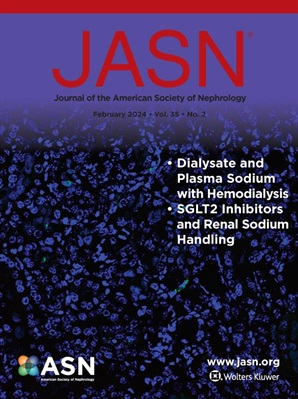慢性肾脏病患者的人群健康管理和指南协调护理:K-CHAMP 的二次分析。
IF 9.4
1区 医学
Q1 UROLOGY & NEPHROLOGY
Journal of The American Society of Nephrology
Pub Date : 2025-05-01
Epub Date: 2024-11-01
DOI:10.1681/ASN.0000000544
引用次数: 0
摘要
背景:慢性肾脏病(CKD)指南协调护理方面的差距会导致不良后果。肾脏协调健康管理伙伴关系(K-CHAMP)群组随机试验测试了人群健康管理干预与常规护理对 CKD 进展和初级医疗机构循证护理服务的影响:K-CHAMP纳入了年龄在18-85岁、eGFR为0.5的成年人:对所有 1,596 名(754 名干预,842 名常规护理)入组患者(平均年龄 74±9 岁,eGFR 37±8 mL/min/1.73m2,928 名(58%)女性,127 名(8%)黑人)进行了分析。中位随访 17 个月后,在调整分析中,干预组患者每年接触 SGLT-2i 的天数(56 天 vs 32 天,相对收益 1.72,95% CI 1.14-2.30)和 GLP-1RA 的天数(78 天 vs 29 天,相对收益 2.65,95% CI 1.59-3.71)显著高于常规治疗。在2019年研究开始时,干预组和对照组中开具SGLT-2i和/或GLP-1RA处方的患者比例相似(分别为8% vs 6%,比率比为1.23,95% CI为0-2.99),但到2022年,干预组患者开具这些药物的比例明显更高(分别为44% vs 27%,比率比为1.63,95% CI为1.32-1.94)。白蛋白尿或中高强度他汀类药物患者在任何过程测量或ACEi/ARB暴露天数方面均无明显差异:K-CHAMP能有效加快SGLT-2i和GLP-1RA的实施,但并没有增加白蛋白尿患者或中高强度他汀类药物使用患者的ACEi/ARB,也没有改善初级医疗环境中CKD患者的血压控制、血糖控制或白蛋白尿检测。本文章由计算机程序翻译,如有差异,请以英文原文为准。
Population Health Management and Guideline-Concordant Care in CKD: A Secondary Analysis of Kidney Coordinated HeAlth Management Partnership.
求助全文
通过发布文献求助,成功后即可免费获取论文全文。
去求助
来源期刊
CiteScore
22.40
自引率
2.90%
发文量
492
审稿时长
3-8 weeks
期刊介绍:
The Journal of the American Society of Nephrology (JASN) stands as the preeminent kidney journal globally, offering an exceptional synthesis of cutting-edge basic research, clinical epidemiology, meta-analysis, and relevant editorial content. Representing a comprehensive resource, JASN encompasses clinical research, editorials distilling key findings, perspectives, and timely reviews.
Editorials are skillfully crafted to elucidate the essential insights of the parent article, while JASN actively encourages the submission of Letters to the Editor discussing recently published articles. The reviews featured in JASN are consistently erudite and comprehensive, providing thorough coverage of respective fields. Since its inception in July 1990, JASN has been a monthly publication.
JASN publishes original research reports and editorial content across a spectrum of basic and clinical science relevant to the broad discipline of nephrology. Topics covered include renal cell biology, developmental biology of the kidney, genetics of kidney disease, cell and transport physiology, hemodynamics and vascular regulation, mechanisms of blood pressure regulation, renal immunology, kidney pathology, pathophysiology of kidney diseases, nephrolithiasis, clinical nephrology (including dialysis and transplantation), and hypertension. Furthermore, articles addressing healthcare policy and care delivery issues relevant to nephrology are warmly welcomed.

 求助内容:
求助内容: 应助结果提醒方式:
应助结果提醒方式:


